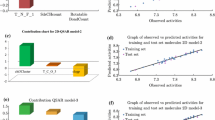Summary
The purpose of this study was to examine the structure/activity relationships of a series of substituted benzamides as poly(ADP-ribose) polymerase inhibitors. The experimental approach has involved the use of in vitro and in vivo assays in order to gather information either on the intrinsic activity of the benzamides or on the effect of various pharmacodynamic parameters on the activity in vivo. Although some discrepancies between the data obtained in vivo and in vitro were found in this study, results seem to indicate that most powerful inhibitors were characterized by acylation of the -NH2 function in the 3 position or by substitution in this same position with hydroxy or methoxy groups. The best inhibitors were not cytotoxic under these experimental conditions. Computed calculations of molecular electrostatic potential of these molecules were also performed and a good correlation was found between the similarity index and the experimental inhibitory activity.
Similar content being viewed by others
Abbreviations
- ADP-Rib polymerase:
-
poly(ADP-ribose) polymerase
- SSF:
-
strand scission factor
- MEP:
-
molecular electrostatic potential
References
Bogert MT, Beans HT (1904) Metaminobenzonitrile and some of its derivatives. J Am Chem Soc 26:476–482
Bollum FJ (1966) In: Cantoni GL, Davies DR (eds) Procedures in nucleic acids research Harper and Row, New York, p 296
Bonaccorsi R, Scrocco E, Tomasi J (1970) Theoretical section progress report 1969/1970. Laboratorio di Chimica Quantistica ed Energetica Molecolare del C.N.R. ed Instituto di ChimicaFisica del' Università di Pisa, Pisa, Italy, pp 35–39
Bonaccorsi R, Pullman A, Scrocco E, Tomasi J (1972a) The molecular electrostatic potentials for the nucleic acid bases: adenine, thymine and cytosine. Theor Chim Acta 4:51–60
Bonaccorsi R, Petrongolo C, Scrocco E, Tomasi J (1972b) Theoretical investigations on the solvation process. Theor Chim Acta 20:331–342
Bowen-Jenkins PE, Richards WG (1986) Quantitative measures of similarity between pharmacologically active compounds. Int J Quant Chem 30:764–768
Bray HG, Ryman BE (1948) Fate of certain organic acids in the rabbit. 0- and m-hydroxybenzoic acids and amides. Biochem J 43:568–572
Campaigne E, Le Suer WH (1948) 3-Substituted thiophenes. J Am Chem Soc 70:1555–1558
Cantoni O, Murray D, Meyn RE (1986a) Effect of 3-aminobenzamide on DNA-strand-break rejoining and cytotoxicity in CHO cells treated with hydrogen peroxide. Biochim Biophys Acta 867:135–143
Cantoni O, Peruzzi G, Cattabeni F (1986b) A method for disposing lysates from cells analyzed for DNA damage by filter elution assay. J Biochem Biophys Methods 12:363–364
Carbo R, Leyda L, Arnau M (1980) How similar is a molecule to another? An electronic density measure of similarity between two molecular structures. Int J Quant Chem 17:1185–1189
Connolly ML (1981) MS molecular surface program. Announced in QCPE Bull 1:75
Dewar MJS, Zoebisch EG, Healy EF, Stewart JJP (1985) AM1: a new general purpose quantum mechanical molecular model. J Am Chem Soc 7:3902–3909.
Gaal JC, Pearson CK (1985) Eukariotic nuclear ADP-ribosylation reactions. Biochem J 230:1–18
Higgins D (1988) Theoretical calculations on large molecules: development of new techniques and the study of enzyme inhibitors. Ph.D. thesis, University of St. Andrews
Hunting DJ, Gowans BJ, Henderson JF (1985) Specificity of inhibitors of poly(ADP-ribose) synthesis: effects on nucleotide metabolism in cultured cells. Mol Pharmacol 28:200–206
Iwasa I, Fujita T, Hasch C (1965) Substituents constants for aliphatic functions obtained from partition coefficients. J Med Chem 8:150–154
Jacobs WE, Heidelberger M (1917) Methods for acylation of aromatic amino compounds and ureas with a special reference to chloroacetylation. J Am Chem Soc 39:1442–1447
James MR, Lehmann AR (1982) Role of poly(adenosine diphosphate ribose) in deoxyribonucleic acid repair in human fibroblasts. Biochemistry 21:4007–4013
Kohn KW, Ewig RAG, Erickson LC, Zwelling LC (1981) Measurement of strand breaks and cross-links by alkaline elutiuon. In: Friedberg E, Hanawalt P (eds) DNA repair: a laboratory manual of research procedures. Dekker, New York, pp 379–401
Milam KM, Cleaver JE (1984) Inhibitors of poly(adenosine diphosphate-ribose) synthesis: effect on other metabolic processes. Science 223:589–591
Ohashi Y, Ueda K, Hayaishi O, Ikai K, Niwa O (1985) Induction of murine teratocarcinoma cell differentiation by suppression of poly(ADP-ribose) synthesis. Proc Natl Acad Sci USA 81:7132–7136
Purnell RM, Whish WD (1980) Novel inhibitors of poly(ADP-ribose) synthetase. Biochem J 178:775–777
Purnell RM, Kidwell WR, Minshall L, Whish WD (1985) Specificity of poly/ADP-ribose) synthetase inhibitors. In:Althaus FR, Hilz H, Shall S (eds) ADP-ribosylation of proteins. Springer, Berlin Heidelberg New York, pp 98–105
Rankin PW, Jacobson EL, Benjamin RC, Moss J, Jacobson MK (1989) Quantitative studies of inhibitors of ADP-ribosylation in vitro and in vivo. J Biol Chem 264:4312–4317
Shall S (1984) Inhibition of DNA repair by inhibitors of nuclear ADP-ribosyl transferase. In Collins A, Downes ML, Johnson RT (eds) DNA repair and its inhibition. IRL Press, Oxford, pp 143–191
Sims JL, Sikorski GW, Catino DM, Berger SJ, Berger NA (1982) Poly(adenosinediphosphoribose) polymerase inhibitors stimulate unscheduled deoxyribonucleic acid synthesis in normal human lymphocytes. Biochemistry 21:1813–1821
Smulson ME, Hough C, Kasid U, Dritschilo A, Lubet R (1985) In: Althaus, FR, Hilz H, Shall S (eds) ADP-ribosylation of proteins. Springer, Berlin Heidelberg New York, pp 207–216
Stewart JJP (1985) MOPAC program package. Announced in QCPE Bull 5:133
Sugimura T, Miwa M (1983) Poly(ADP-ribose)transferase and cancer research. Carcinogenesis 4:1503–1506
Thomson C, Higgins D, Edge C (1988) Theoretical studies of the electrostatic potential of some enzyme inhibitors using computer graphics techniques. J Mol Graphics 6:171–177
Weinstein H, Osman R, Green JP, Topiol S (1981) In: Politzer P, Truhlar DG (eds) Chemical applications of atomic and molecular electrostatic potentials. Plenum Press, New York
Author information
Authors and Affiliations
Rights and permissions
About this article
Cite this article
Sestili, P., Spadoni, G., Balsamini, C. et al. Structural requirements for inhibitors of poly(ADP-ribose) Polymerase. J Cancer Res Clin Oncol 116, 615–622 (1990). https://doi.org/10.1007/BF01637083
Received:
Accepted:
Issue Date:
DOI: https://doi.org/10.1007/BF01637083



